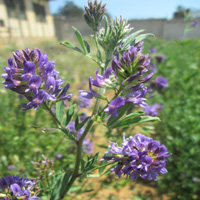Adaptation patterns of sixteen alfalfa (Medicago sativa L.) cultivars across contrasting environments of Algeria and implications for the crop improvement

Accepted: 18 February 2020
HTML: 161
All claims expressed in this article are solely those of the authors and do not necessarily represent those of their affiliated organizations, or those of the publisher, the editors and the reviewers. Any product that may be evaluated in this article or claim that may be made by its manufacturer is not guaranteed or endorsed by the publisher.
The additive main effects and multiplicative interaction analysis was applied to assess the genotype × environment interaction (GEI) effects and stability for 4-year dry matter yield (DMY) of 16 alfalfa (Medicago sativa L.) cultivars of diversified geographic origin grown in four Algerian environments given by the combination of two water managements (rainfed and irrigated) and two evaluation sites, viz. the sub-humid location of Alger and the semi-arid, salinity-affected site of Hmadna. The analysis of variance (ANOVA) revealed significant variation among cultivars and environments (P<0.001). The GEI was significant (P<0.001) and the environment main effect had greater influence than the genotype effect on long-term yield according to ANOVA. Rainfed conditions had 41.6% and 48.5% lower yield than the irrigated ones in Alger and Hmadna, respectively. Alfalfa cropping in the semiarid location caused lower DMY than in the sub-humid one (– 38.0% under irrigated and –45.2% under rainfed conditions) and a slightly lower persistence over the 4-year period. Outstanding environment-specific cultivar responses were observed, fully justifying the large GEI effects, although the Italian cultivar Sicilian ecotype had remarkable yield stability and good mean yield. The American variety Ameristand 801S and the Moroccan landrace Erfoud 1 were the most salt-tolerant cultivars. The evaluated germplasm, and particularly some exotic cultivars, could be used as parents to breed new varieties more adapted to drought and salinity in the Mediterranean basin.
How to Cite
PAGEPress has chosen to apply the Creative Commons Attribution NonCommercial 4.0 International License (CC BY-NC 4.0) to all manuscripts to be published.

 https://doi.org/10.4081/ija.2020.1578
https://doi.org/10.4081/ija.2020.1578



